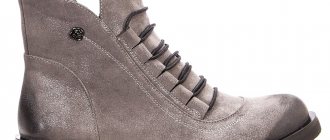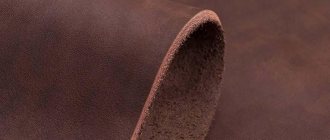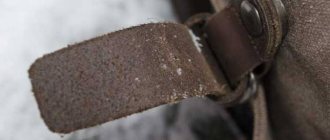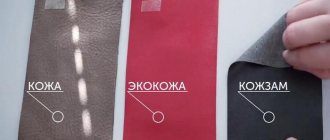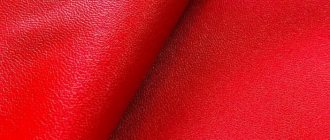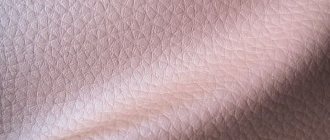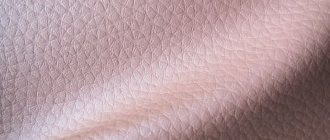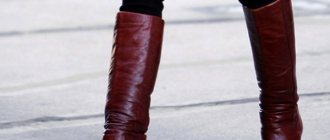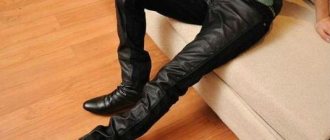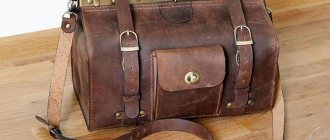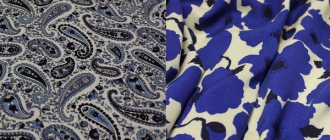For the health of the musculoskeletal system, the type of shoes we wear is very important. It needs to fit well, fit properly, and be made from high quality material to last long enough. Many consumers choose shoes made of genuine leather for daily wear, rejecting products made from artificial leather and eco-leather. What should you pay attention to when shopping in a shoe store in order to purchase a truly high-quality product that you won’t have to return after the first wear? What kind of leather do modern manufacturers make shoes from, and should the buyer overpay for naturalness?
High-quality shoes - what are they made of?
The assortment presented in retail outlets is simply dizzying. Ballet flats, sandals and sandals are replaced by moccasins and pumps, followed by windows filled with shoes and boots. The main selection criterion is the quality of the products that will have to be worn on your feet. What materials are shoes made from in factories?
A natural skin
Ideal for sewing shoes. It is strong, durable and practical. This is a soft, warm and comfortable material from which you can make a variety of models for all seasons. Its cost is quite high, but it pays off in the longevity of its operation.
What leather are shoes made from?
- calf - very soft and durable, suitable for embossing;
- pork - the cheapest, used for sewing products in the budget segment;
- cowhide - for the middle price segment, quite tough, but has a noble appearance;
- bull - not suitable for creating sophisticated things, but does not get wet and is inexpensive;
- crocodile - used for the manufacture of exclusive products, its price is high, and its appearance is luxurious;
- deer - used for sewing slippers, it is characterized by wear resistance and excellent heat-saving properties.
Leather products require careful care. This is an absolutely safe “breathable” material that does not cause allergies or irritation.
Faux leather
What else are shoes made from to minimize their cost? Made from artificial leather, the price of which is significantly lower than natural leather. It has some advantages:
- does not get wet longer in bad weather;
- maintains model shape;
- Easily painted in different colors.
However, faux leather boots will not withstand very low temperatures, and sandals or shoes that do not allow air to pass through will cause your feet to sweat a lot. The disadvantages also include the low durability of the products - they will last a maximum of 1 season.
Synthetic leather
Leatherette has long been popular among consumers. Shoes made of leatherette are cheap, but during active wear they quickly become deformed. At first glance, it is quite difficult to distinguish this material from leather, but when you touch its surface, you immediately feel the difference - there is no heat transfer. Leatherette can be recognized by its knitted or cotton inner base.
Combination skin
To reduce the cost of a pair of shoes, manufacturers use some tricks. Today, the demand for products made from combination leather has increased - durable and safe shoes, but what this is needs to be explained. The main characteristics of such shoes are environmental friendliness, practicality, and comfort for the feet. What is combination shoe leather? This is a combination of natural and artificial materials, their proper arrangement in the model depending on the purpose of a particular area. How are these shoes made? Natural material is used for parts that should be elastic, durable and breathable, and non-natural raw materials are used for the rest of the design.
How to determine the material of shoes if visually different models look almost the same? There are some tricks that will allow buyers to choose quality.
Subcutaneous fat
Subcutaneous fat, or hypodermis, is the lowest layer of skin, located under the dermis. It consists of fat lobules separated from each other by connective tissue septa containing collagen and penetrated by large vessels. The main cells of fat lobules are adipocytes, the number of which varies in different areas of the body. Currently, PFA is considered not only as an energy depot, but also as an endocrine organ, the adipocytes of which are involved in the production of a number of hormones (leptin, adiponectin, resistin), cytokines and mediators that affect metabolism, insulin sensitivity, reproductive and immune functional activity. systems
How to choose leather shoes
High-quality footwear is not cheap, so you don’t want to spend a lot of money on moccasins, boots or shoes that will become unusable after a short period of wear. How to determine whether shoes are leather or not? You need to know what is typical for natural materials.
- How to check whether shoes are leather or not right at the point of sale? You need to place your palm on the top surface of the product and wait until it warms up and begins to give off heat. If the products are made of leatherette, you will not feel any thermal changes.
- Take the product in your hands and touch the reverse side. For non-natural models it is made of fabric, while for those made of leather it is harsh, similar to suede.
- How are shoes made from artificial materials? Due to the fleecy nature of the fabric lining, leatherette products are sewn by folding the sections inward. Leather shoe pairs usually have untreated seams and open edges.
- Sometimes combination leather is passed off as genuine - what kind of well-tailored shoes should it be for the consumer to give it their choice? Manufacturers add non-functional small inserts to models made from cheap material or attach a leather tag, misleading the buyer.
- You can do a water test. One drop is enough, which, when it hits the surface, will harden and begin to be slowly absorbed, rather than spreading and flowing, to make sure that you have a leather pair in front of you.
Raw materials and manufacturing
Pressed leather is a processed raw material consisting of leather scraps to which synthetic fibers have been added. These can be: polyamide, polyesters, thermoplastic resins and polyethylene.
A mixture of natural and artificial fibers is heated and brought to a liquid state. After this, mix well and allow to cool. As a result of simple manipulations, pressed leather is obtained that looks like natural leather.
The complete production process looks like this:
- Any remnants of natural material (trimmings, pieces) are crushed mechanically using a special device.
- The composition is cleaned of debris, impurities, and too large parts.
- Binder components are added: resins and synthetic fibers.
- On the forming apparatus, the composition begins to be pressed to obtain a uniform, flat sheet.
- The layer is placed in a furnace, melted and pressed again at high temperature.
The remaining processes depend on what result the manufacturer wants to achieve in the end. As a rule, the material is painted in the desired color and given the desired texture.
This is interesting! Technologists often use second-rate raw materials, using scraps that remain after pressing. Products made from such leather are less practical to wear. They quickly crack, scuffs and bends occur.
Rules for conducting a visual inspection
How can you tell if a shoe is leather or not by looking at it? When performing a visual inspection, you must follow the advice of specialists.
- Look for a graphic tag, sticker or imprint with a genuine leather symbol.
- Check the pairing of shoes. The material must be uniform, the same color, the trim and cut should be symmetrical, the height and elasticity of the backdrop should be identical.
- The decorative bezel can lag behind the side surface by a maximum of 1 mm.
- Heels must be the same height - the maximum permissible difference is up to 2 mm. Good quality is indicated by the absence of cracks and distortions.
- How to identify leather shoes by eye? Pay attention to the sole. Its thickness should be uniform, and the parts should fit tightly to the bottom and stitched with stitches without gaps.
Good leather shoes cannot be cheap. A price that is too low should alert the buyer - perhaps this is an excellent fake. Buy products only in specialized stores with an impeccable reputation, where the quality of the product is confirmed by specialists.
You may be interested in: How to care for suede shoes How to remove unpleasant odor from shoes Water softening: quickly removing harmful impurities
Types of leather by purpose
According to purpose, natural leather can be classified into the following types:
- Designed for making shoes.
- It is made mainly from the skins of cattle and pigs. Used in the production of horse tack, holsters, belts, bags and leather accessories. Leather is characterized by maximum wear resistance and reliability.
- Durable leather, used for drive belts, made from cattle hides.
- The softest material is mainly the skins of sheep, goats, pigs, and foals. Used for the production of leather clothing and bags.
What is dysplastic nevus syndrome?
Nevus dysplastic syndrome or FAMMM is a syndrome of familial atypical multiple melanoma. It is diagnosed if the patient has multiple (>50) melanocytic nevi, among which there are atypical (dysplastic) ones, and there is a case of melanoma in relatives of 1-2 degrees.
The development of melanoma is observed in 35% of cases in patients with FAMMM syndrome. For FAMMM syndrome, observation by an oncologist, dermatologist, and ophthalmologist is recommended once every 3 months.
Which moles have melanoma potential?
Among benign neoplasms with melanomatous potential, the most relevant are:
- congenital melanocytic nevi;
- acquired atypical (dysplastic) melanocytic nevi.
Congenital melanocytic nevi are divided into small ones - up to 1.5 cm in size, the risk of developing melanoma is from 1 to 5%; medium – ranging in size from 1.5 to 20 cm, the risk of developing melanoma – from 1 to 6.3%: observation by a dermatologist and surgical excision with histological examination if changes are detected are recommended.
It is recommended to be monitored by a dermatovenerologist once every 3-6 months - dermatoscopy of each element on the skin and photo documentation (mapping) of uneven moles for observation in the following cases:
- the presence of melanoma in one of the close relatives (parents, children, siblings);
- immunosuppression - suppression of the immune system due to medication or illness;
- the presence of 100 or more moles (more than 11 moles on one forearm);
- the presence of 5 or more clinically atypical (dysplastic) nevi;
- previous history of skin cancer.
Giant nevi have a size of more than 20 cm or 5% or more of the body surface area, the risk of developing melanoma is from 6.3% to 33.3%.
It is advisable to remove giant congenital nevi as early as possible, since the risk of developing melanoma is high even in the first 3-5 years of the patient’s life. Treatment is carried out by an oncological surgeon using excision and plastic correction.
What is skin cancer in situ?
This is a special form of skin cancer (cancer in situ), i.e. local intraepithelial pre-invasive malignant process that does not extend beyond the skin. The most relevant of these processes are Bowen's disease, Queyre's erythroplasia, keratoacanthoma and Dubreuil's melanosis (lentigo maligna), which were previously classified as precancerous diseases.
According to modern concepts, Bowen's disease is an intradermal non-invasive squamous cell carcinoma of the skin. Keir's erythroplasia is Bowen's disease of the genital skin. Keratoacanthoma or sebaceous molluscum is a well-differentiated squamous cell carcinoma.
Diagnosis is carried out by a dermatologist and oncologist, and treatment is carried out by an oncological surgeon.
What are atypical (dysplastic) nevi?
An atypical or dysplastic or atypical nevus is an acquired pigmented formation, a variant of benign melanocytic nevi, which has the following characteristics:
- uneven edge and/or asymmetrical shape;
- size is usually more than 6 mm;
- color brown, black, red at the same time;
- the central part can be raised, the peripheral part can be flat like a fried egg, or it can be completely flat.
There are single (<5) and multiple (>5) dysplastic nevi. There are also hereditary and non-hereditary variants.
The final diagnosis of “dysplastic nevus” is established only after histological examination. Thus, not all moles that look dysplastic in appearance will turn out to be so after removal and examination. The structure of a dysplastic nevus includes lentiginous melanocytic dysplasia of degrees 1, 2, 3.
Dysplastic nevi do not always degenerate into cancer. Against the background of dysplastic nevi, skin melanoma develops only in 9% of cases.
Most of them decrease or resolve over time, or transform into intradermal melanocytic nevi (Lamotkin I.A., 2017).
It is necessary to exclude trauma to moles (scrubs, peelings, massage, chains, cosmetic cleansing, frequent combing, hair removal, etc.)
Observation by a dermatologist with dermatoscopy and photographic recording of nevi once every 6 months, surgical excision of changing or suspicious nevi are indicated.
What factors contribute to the transformation of precancerous conditions into cancer of the skin and mucous membranes?
In relation to the human body, these factors can be divided into external and internal.
External factors:
- visiting a solarium;
- excessive exposure to sunlight/ultraviolet radiation;
- getting sunburn;
- prolonged contact with chemicals (dyes, pesticides, arsenic, petroleum derivatives, coal);
- temperature factors (frostbite, chapping, burns);
- receiving frequent or permanent mechanical injuries (irritation);
- stay in the area of ionizing radiation (X-rays, radiation);
- psycho-emotional chronic stress.
Internal factors:
- immunodeficiency, immunosuppressive therapy, autoimmune diseases;
- cases of malignant skin tumors in the family (heredity);
- increased sensitivity to UV rays, photodamage;
- human papillomavirus (HPV) of high oncogenic risk (types 16, 18, 31, 33, 35, 39, 45, 49, 51, 52, 56, 58, 59, 68);
- drinking alcohol and smoking;
- age (60-80 years), age-related skin changes, some chronic inflammatory and occupational skin diseases;
- previous skin cancer;
- lack of timely treatment of benign and precancerous skin pathologies.
Exposure to fire
You will not be allowed to conduct this experiment in a store due to the risk of damage to the product, but you can try it at home. It is known that genuine leather does not burn well, and therefore you can try to bring a lit match or lighter to a sample of the material that comes with the product for a few seconds at a short distance. The genuine material will not react in any way to such an impact, and the leatherette will begin to melt. But the method fails if the leather product is treated with aniline, which ignites at the slightest contact with fire.
